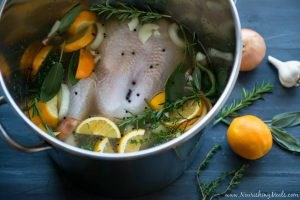This content was originally published by the Longmont Observer and is licensed under a Creative Commons license.
Sorry Longmont. I had hoped to promote local turkeys this week, birds grown in area farms that strut around the farm, “naturally mating” and living a “long productive outdoor lifespan” with a “slow growth rate,” criteria established by The Livestock Conservancy that define the term “heritage turkey.” However, there are none to promote.

“We are sold out of turkeys,” said Aaron Rice last week at the Saturday Longmont Farmers Market. The only dedicated poultry operation at the market, Rice’s Jodar Farm, currently operating in Fort Collins, is planning to expand operations in the coming months—so keep an eye out for next year’s Thanksgiving table centerpiece. Rice did mention that he has plenty of Italian and German sausage for sale for your stuffing, which will make a tasty side dish.
Locally grown turkeys, especially heritage breeds that help to preserve biodiversity in the line, are worth seeking out. The flavor of the meat in a bird that lives outdoors and eats insects is incomparable to the meat from factory farmed poultry. The flavor is rich and deep, more closely related to wild turkeys, though the meat from those birds is lean and requires special preparation to promote a juicy end product. One of those special methods is brining.
Brining turkeys is often debated and an understanding of the process can help you make your decision.
If you have high blood pressure and strive to avoid salt, don’t brine. Several years ago, cooking for a crowd, I did some controlled testing to try to determine if brining made a difference. There are several things to consider and you can get philosophical on the issue.
To brine, or not to brine, that is the question. One year, we cooked a trio of turkeys for a crowd. Our small army of cooks roasted two organic, free-range turkeys from local farms and compared the flavor to one of the free turkeys given away by a local supermarket as a bonus reward. One of the free-range turkeys, a large boned Red Bourbon, was brined first, that is, soaked in a solution of salt and water for 6 hours before cooking. The other, a Broad Breasted White raised on an Amish farm, was not brined but treated to the same butter and herb rub as the other birds. The vote at the table was clearly in favor of the Red Bourbon, for its moist meat with exceptional flavor.
Thanksgiving dinner is the most challenging dinner of the year for most cooks. The last thing anyone needs is to add something to their To Do list, particularly something like, “Give the turkey his sea salt spa treatment.” Besides, the turkey is almost incidental to the meal; the real stars are the side dishes, the glimmering cranberry chutney, the fluffy mound of mashed potatoes, the candied sweet potatoes. Who cares what the turkey tastes like? We’re all used to a dry, bark-like texture for turkey meat, which is why the gravy has to be good.

Try brining. Using a Cook’s Illustrated article for guidance (I used an article before this updated link that required more salt) I massaged 2 pounds of Kosher salt into the 13 pound bird before filling up a large plastic tub with enough cool water to cover. I had a commercial refrigerator large enough to hold the container, but an insulated cooler works well and ice packs can be used to keep the temperature of the water at 40°. Generally, the weather cooperates in November; just keep your instant read thermometer handy. An hour before going into the oven, the bird was rinsed thoroughly, placed upon a rack and allowed to air dry before going into a 400° oven.
Brining relies on food science principles of diffusion and osmosis to denature proteins so they form a matrix that holds more water. In plain English, when the turkey is submerged in a salt solution, diffusion causes the salt to migrate into the turkey meat so that there is equilibrium in the system, that is, the turkey in the liquid. Similarly, osmosis causes water in the brine to migrate into the turkey cells so that there is balance within the system. The salt causes the proteins in the turkey to unravel and interact with each other and to form a sticky gel that holds moisture. The result is a juicier roasted turkey because of the increase of water and a more flavorful turkey because of the additional salt.
Not all turkeys need brining. Some frozen turkeys are already injected with a water-salt solution. Kosher turkeys are processed with salt. The birds that need the treatment are the regular frozen turkeys and the free range, minimally processed birds. If you don’t want to experiment with a major player like the Thanksgiving turkey, try the brining technique on a chicken or a Cornish hen. But at some point, do try brining—you’ll have one more thing to be thankful for.
Oven-Roasted Brined Turkey with Giblet Pan Sauce
Serves 10-12
- 1 turkey, (12-14 pounds), with giblets removed and reserved
- 2 pounds Kosher salt (or 1 pound regular table salt)
- 3 medium onions, chopped rough
- 2 medium carrots, chopped rough
- 2 stalks celery, chopped rough
- 6 sprigs fresh thyme
- 1 bay leaf
- 1 stick melted butter
- 3 tablespoons cornstarch
- 1/2 cup of cold water
Rinse turkey, and place a container just large enough to hold it comfortably. Rub the salt into the body cavities and skin, all over the bird. Add cold water to cover entirely, stirring the water so the salt dissolves. Set the turkey in a refrigerator, cooler or outdoors if the temperature is 40° for 4 to 6 hours. Remove the turkey from the brine and rinse both cavities and exterior surfaces under cool running water for several minutes until all crystalline traces of the salt are gone.
Put the giblet parts (reserving the liver for another use or adding it during the last 5 minutes of cooking time) in a large saucepan with one third of each of the chopped vegetables, 2 thyme sprigs and the bay leaf. Add 6 cups of water and bring to a boil. Simmer, uncovered, for about an hour. Strain the broth and set the neck and giblets parts aside until cool then refrigerate until ready to use.
Heat oven to 400°F. Toss another third of the rough chopped vegetables and 2 sprigs thyme with the melted butter and place in the large body cavity. Tie turkey legs together and tuck the wings under and tie with string.
Place the remaining third of the vegetables and the remaining 2 sprigs of thyme on the bottom of a large roasting pan. Place the turkey on a sturdy rack and allow to air dry for 20-30 minutes. Brush the surface of the turkey with melted butter and roast, basting every 30 minutes, until the thermometer inserted in the thickest part of the thigh registers 165-170°F, about 3 hours.
Remove the rack and turkey from the roasting pan and set on large baking tray to catch the juices. Tent the turkey with foil, drape with heavy towels and allow to rest for 30 minutes so the carry over cooking raises the temperature to 180°F.
Strain the pan drippings into a large saucepan, discarding the solids. Skim the fat. Place the broiler pan on two burners and add 3 cups of stock and whisk up the browned bits (actually caramelized proteins that add flavor to the finished sauce). When the broiler pan is clean and the stock is simmering, strain the stock into the saucepan with the pan drippings. Finely dice the giblets (and liver) if you want to add them to the sauce. Bring the mixture to a boil. Mix the cornstarch with the half cup of cold water and whisk gradually into the saucepan. Bring to a boil until the sauce thickens slightly. Carve the turkey and pass the sauce separately.
Brining Formula:
For a basic brine, use one quart of water mixed with one half cup of Diamond Crystal Kosher salt (or one fourth cup of regular table salt or one fourth cup plus two tablespoons of Morton Kosher salt). One half cup of sugar can be added to the brine and will result in more browning. The amount of brine is one quart per pound of food, not to exceed 2 gallons of brine. Plan on one hour per pound of product, but not less than 30 minutes and not more that 8 hours. Items that are brined for a longer time may be too salty and their pan juices are unusable. Best choices for brining are: Cornish hen, chicken, turkey, pork a whole side of salmon and shrimp.


